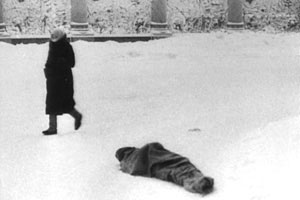
When faced with such devistating horror denial is a natural, and perhaps sometimes healthy, response. So for much of the documentary “Blockade” I simply told myself it wasn’t real. It was easy to do — the “plot” follows so much of the George Romero-esque horror flick format.
War comes to Leningrad. The city digs in. The first bombs hit. A few buildings collapse, but that’s okay. Then more buildings. Then no food. No heat. No water. Then winter comes. And disease. And over 900 days Leningrad slowly mutates into an unimaginable hell — a beautiful city filled with stately architecture and artwork is now strewn with frozen bodies. Citizens chip ice off the side of the street for water. A modern city reduced to wondering zombies, busy streetcars have been replaced with handcrafted sleds dragging sloppily shrouded dead relatives.
Until, eventually, the war ends.
Even if you aren’t interested in WWII or the Soviet Union, I recommend this movie if you are at all interested in sound design. Director Sergei Loznitsa presents us solely with found footage (and what footage!) and nothing else. The sound design, created out of whole cloth, is a mile thick. No dialogue, but a spellbinding drone of realistic humanity. The track alone without the picture is a remarkable piece of work; a standalone objet d’art, the “soundtrack of suffering.”
On line outside the theater I got into a conversation with a woman who was heading into the same screening. I basically asked her “why the hell are we about to subject ourselves to this?” Her response was something on the order of “it’s the least we can do.” I’d like to think that if I experienced something like the Blockade of Leningrad some people would be willing to take a little time out of their day to try and understand what it was like.







